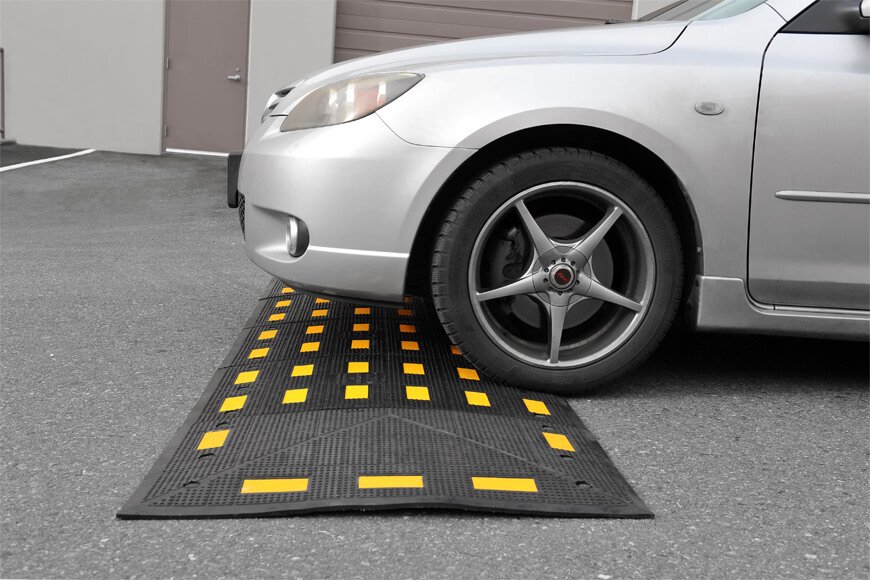When it comes to ensuring road safety, speed bumps play a role in slowing down vehicles and preventing accidents. These raised structures, also referred to as speed humps or traffic calming measures, are strategically designed to compel drivers to decrease their speed. While some may view speed bumps as an inconvenience, they serve as a tool in fostering roads and safeguarding pedestrians, cyclists, and other road users. In this blog post, we will delve deeper into the ways in which speed bumps contribute to enhancing road safety.
1. Decreasing Speed
One of the objectives of speed bumps for sale is to lower the velocity of vehicles within areas. By slowing down the flow of traffic, speed bumps create an environment for everyone sharing the road. When drivers encounter a speed bump, they are compelled to reduce their pace, thereby reducing the risk of losing control of their vehicle or being involved in a collision. This aspect holds significance in places with pedestrian activity, like school zones or residential areas.
2. Improving Visibility
Speed bumps are often painted with colors and equipped with reflective markings that enhance their visibility, particularly during nighttime or when light conditions are poor.
By increasing the visibility of speed bumps to drivers, it allows them to be more prepared and adjust their speed accordingly. This ensures that drivers are aware of the obstacle and reduces the chance of braking or swerving, which can lead to accidents.
3. Protecting Pedestrians
One of the benefits of speed bumps is the protection they provide for pedestrians. Crosswalks and areas with high pedestrian traffic can be particularly risky as drivers may not notice pedestrians in time or ignore traffic regulations. Strategically placing speed bumps in these areas helps reduce vehicle speed, giving pedestrians time to safely cross the road and decreasing the likelihood of accidents. By slowing down vehicles, speed bumps discourage driving or speeding, ultimately making roads safer for pedestrians.
4. Encouraging Safer Driving Behavior
Speed bumps not only physically slow down vehicles but also serve as a reminder for drivers to follow speed limits. The presence of speed bumps encourages motorists to be more cautious and attentive while driving. Drivers are compelled to pay attention to road signs, traffic laws, and pedestrians promoting driving behavior overall. The constant reminder to slow down helps foster a culture of driving, ultimately making roads safer for everyone.
5. Preventing Activities
Speed bumps also have a role to play in preventing activities like street racing or reckless driving. Adding obstacles that make vehicles slow down speed bumps discourages drivers from engaging in behaviors. These safety measures make it harder for drivers to exceed speed limits or perform maneuvers, reducing the likelihood of activities that put both drivers and pedestrians at risk.
6. Protecting Vulnerable Road Users
Vulnerable road users, such as cyclists or motorcyclists, are more prone to accidents due to their protection compared to motorists. Speed bumps can help safeguard road users by prompting drivers to reduce their speed and be more cautious while sharing the road. By minimizing speed differences between vehicles and vulnerable road users, speed bumps contribute to creating an environment for everyone.
7. Encouraging Compliance with Speed Limits
Speed bumps are often strategically placed in areas where drivers tend to surpass speed limits. These areas may include zones, school zones, or near hospitals. The intention behind installing speed bumps is to remind drivers about the importance of following speed limits. When encountering these obstacles, drivers are compelled to slow down, reinforcing the necessity of complying with speed regulations. In the end, this leads to making roads safer and lowering the chances of accidents occurring.
Conclusion
To summarize, speed bumps are a tool for enhancing road safety. They help in decreasing speeds, improving visibility, safeguarding pedestrians, promoting driving habits, discouraging activities, and protecting vulnerable road users. Although they may cause some inconvenience to drivers, the advantages of having speed bumps outweigh the delays they might cause. By placing speed bumps in locations, we can significantly reduce the risk of accidents and encourage responsible driving behaviors.

